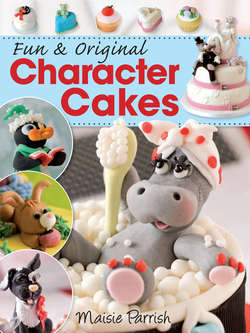Читать книгу Fun and Original Character Cakes - Maisie Parrish - Страница 12
ОглавлениеCovering Cakes
Most beginners can successfully cover a cake with sugarpaste. However, a professional finish – a glossy surface free of cracks and air bubbles with smooth rounded corners – will only result from practise.
1 Prepare the cake with a layer of buttercream (see page 24) or apricot glaze and marzipan (see page 28) depending on whether it is a sponge or a fruit cake.
2 Take sufficient sugarpaste to cover the complete cake. The quantity required for each of the cakes in this book is given at the start of each project. Work the paste until it is quite soft and smooth, then place it on to a surface lightly dusted with icing (confectioners’) sugar.
3 Roll out the paste with a non-stick rolling pin – spacing rods can be used to maintain a uniform thickness (A). The depth of the paste should be approximately 4mm (⅛in). As you roll the paste, move it regularly to ensure it has not stuck to the surface.
4 Measure the cake by taking a measuring tape up one side, over the top and down the other side. The sugarpaste should be rolled out in the shape of the cake to be covered (round for a round cake, square for a square cake and so on), and rolled out a little larger than the measurement just made.
Tip
When covering a cake, try to do it in-natural daylight, as artificial light makes it more difficult to see flaws. Sometimes imperfections can be covered, but sometimes they will occur where you are not going to put decorations so you need to strive for a perfect finish every time. However, if things don’t go to plan, don’t worry, the sugarpaste can be removed and re-applied.
5 Lift and drape the paste over the cake using a rolling pin (B). Carefully lift the sides of the paste, brushing the top surface of the cake in one direction to eliminate any air trapped in between. Continue to smooth the top with the palm of your hand and then use a smoother (C).
6 For the sides, lift, flatten and rearrange any folds at the bottom removing any creases. Do not smooth downwards as this may cause a tear at the top edge. With your hand, ease the sugarpaste inwards at the base and smooth the sides with an inward motion using your hand and a smoother.
